Women driving clean cooking with bioenergy in sub-saharan Africa
 Canva Pro
Canva Pro Canva Pro
Canva Pro· 13 min read
Energy access remains one of the most pressing developmental challenges in sub-Saharan Africa (SSA). With approximately 600 million people, almost half the population, lack access to electricity, and over 900 million still rely on traditional biomass such as wood, charcoal, and agricultural residues for cooking (IEA, 2022). The electrification agenda in SSA has achieved notable progress, with rural electrification initiatives and off-grid solar solutions helping millions gain access to basic energy services.
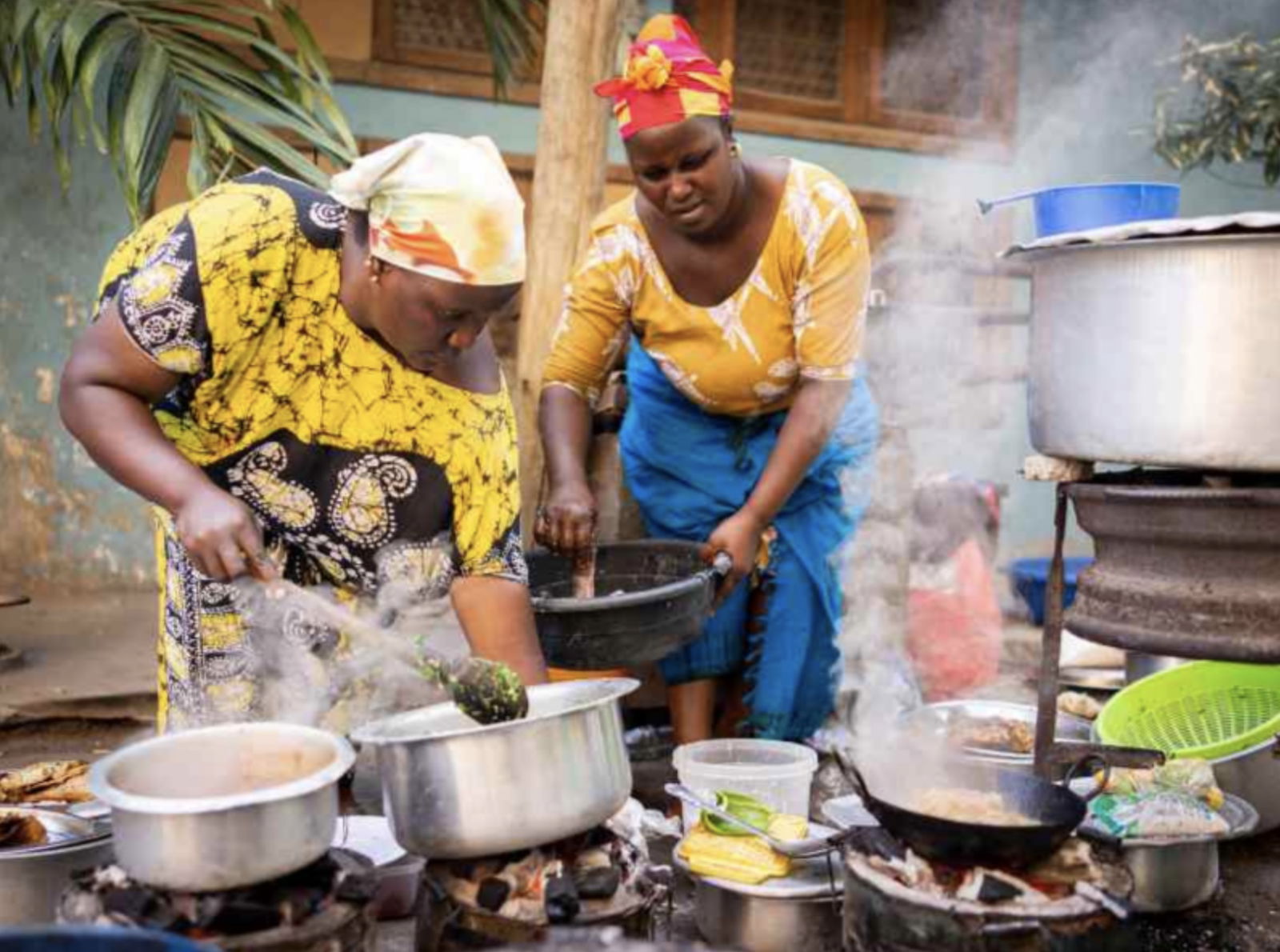
Women cooking outdoors using traditional stoves, highlighting the labor-intensive nature of meal preparation and the reliance on biomass fuels in many rural or peri-urban settings (Source: ESI Africa, 2024)
However, the focus on electricity has overshadowed the critical need for clean cooking technologies. Electrification programs often fail to address the specific energy requirements of rural households, where cooking represents the primary energy demand. For instance, even electrified households frequently continue to use biomass for cooking due to the high costs of electric stoves and unreliable power supply. This disconnect reflects a broader misalignment in global energy priorities. While investments in renewable electricity generation such as wind and solar have surged, clean cooking programs have struggled to attract funding and policy attention. The International Energy Agency estimates that achieving universal clean cooking access by 2030 would require $4.5 billion annually, yet current investments fall far short of this target. That means, bridging this gap will require concerted efforts to elevate clean cooking as a central pillar of energy access initiatives.
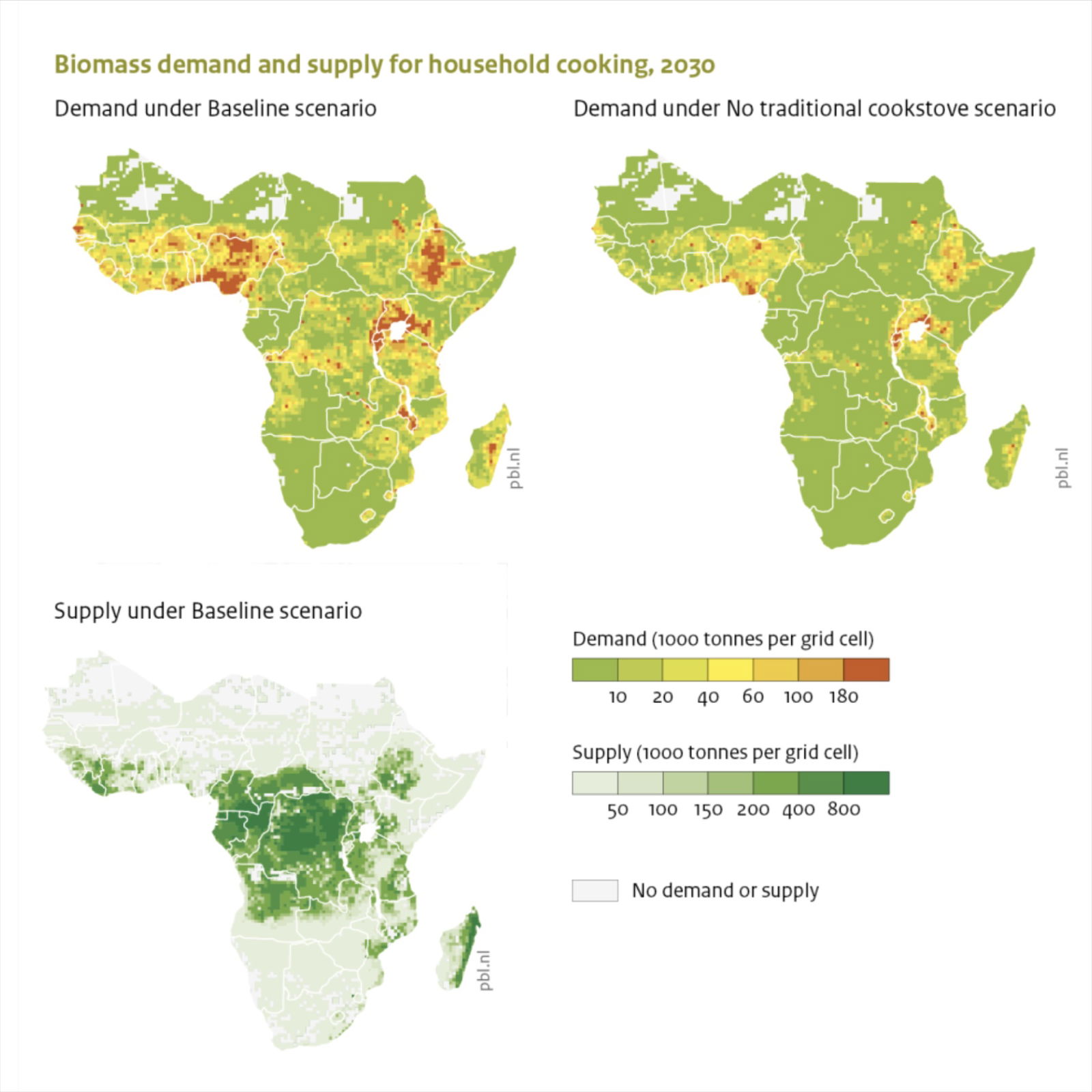
The graph above depicts Sub-Saharan Africa’s biomass demand and supply for household cooking in 2030. Under the baseline scenario, demand remains high in densely populated regions, while supply is concentrated in central and southern areas. Transitioning to cleaner technologies reduces demand, highlighting the need for policy interventions to address health, environmental, and energy inequalities (Source: PBL)
This dependence on unsustainable fuels by low income households contributes to the constant marginalisation of women and rural communities. Women are disproportionately burdened by these energy deficits, as they are often tasked with fuel collection and food preparation, roles that perpetuate cycles of poverty and limit their opportunities for education, income generation, and leadership .
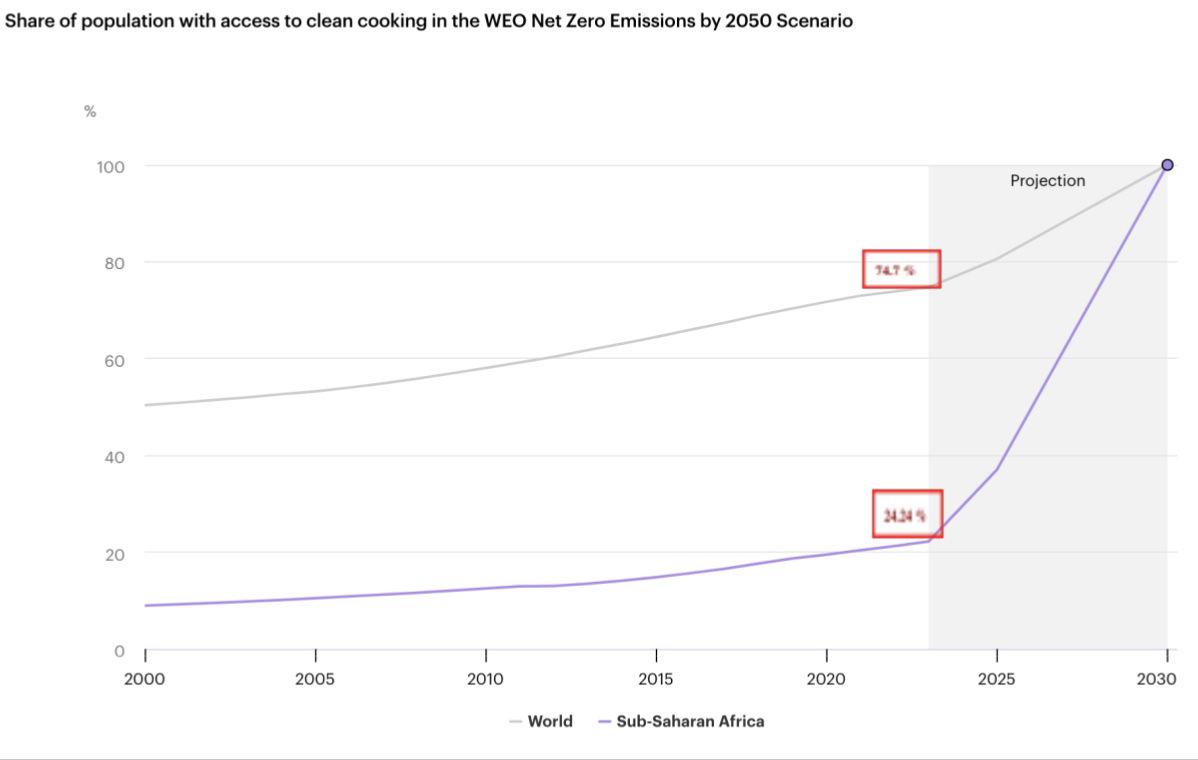
As illustrated in the graph above, access to clean cooking solutions in sub-Saharan Africa remains significantly behind the global average. In 2023, only 22.4% of the population in SSA had access, reflecting minimal progress over the years compared to steady global improvements reflecting about 74.7% from the world. (Source: IEA.Licence: CC BY 4.0)
The NZE’s 2025 target is unlikely to be met without immediate progress, making initiatives like this proposal crucial. Addressing the slow adoption of clean cooking solutions, particularly through programs empowering women, can reduce health risks, environmental damage, and accelerate energy transitions. The FAO reports Sub-Saharan Africa loses 3.9 million hectares of forest annually due to fuelwood collection, worsening soil erosion, reducing agricultural productivity, and increasing climate vulnerability.
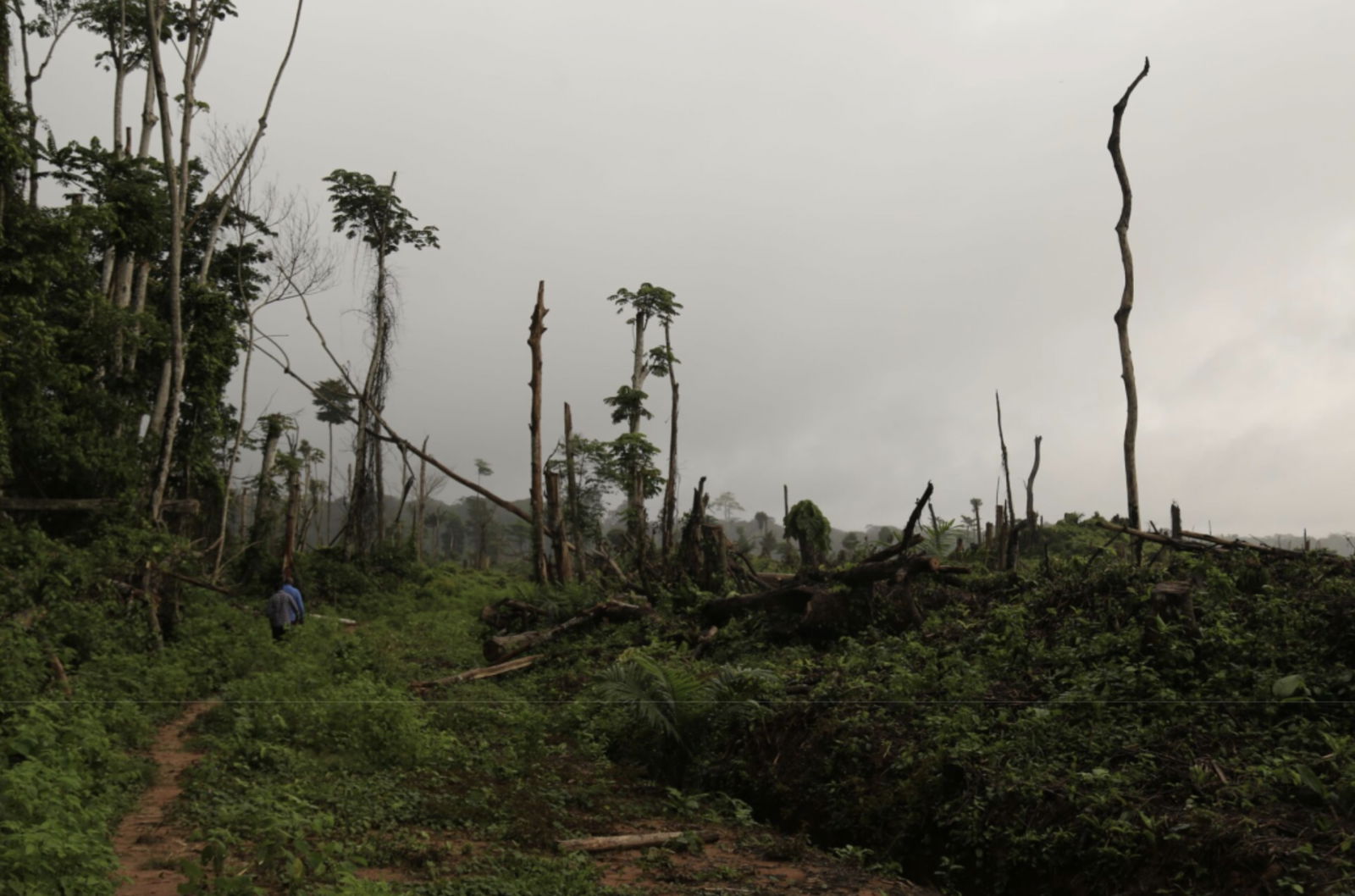
Tree stumps scar the forest floor after 850 hectares were felled to plant oil palms in the heart of the Mau forest. There is strong pressure on the local forests due to deforestation. In less than two months, more than 200 hectares of trees were cut down. The forest of the Nyiragongo volcano will soon be nothing but stumps (Source: Samir Tounsi/AFP via Getty Images)
Energy poverty stifles economic opportunities in SSA, particularly for women. In rural areas, women spend an average of 20 hours per week collecting firewood, time that could be used for education, small-scale entrepreneurship, or agricultural activities (UNDP, 2022). This time burden perpetuates poverty cycles, as women are denied opportunities to contribute to economic productivity or accumulate wealth.
In addition, the high costs associated with inefficient biomass usage weigh heavily on household budgets. Households that rely on purchased charcoal or firewood often spend 10–30% of their income on these fuels, diverting resources from education, healthcare, and other essential needs (IRENA, 2015).. In contrast, clean cooking solutions such as biodigesters can reduce household energy costs by providing a sustainable and affordable alternative.
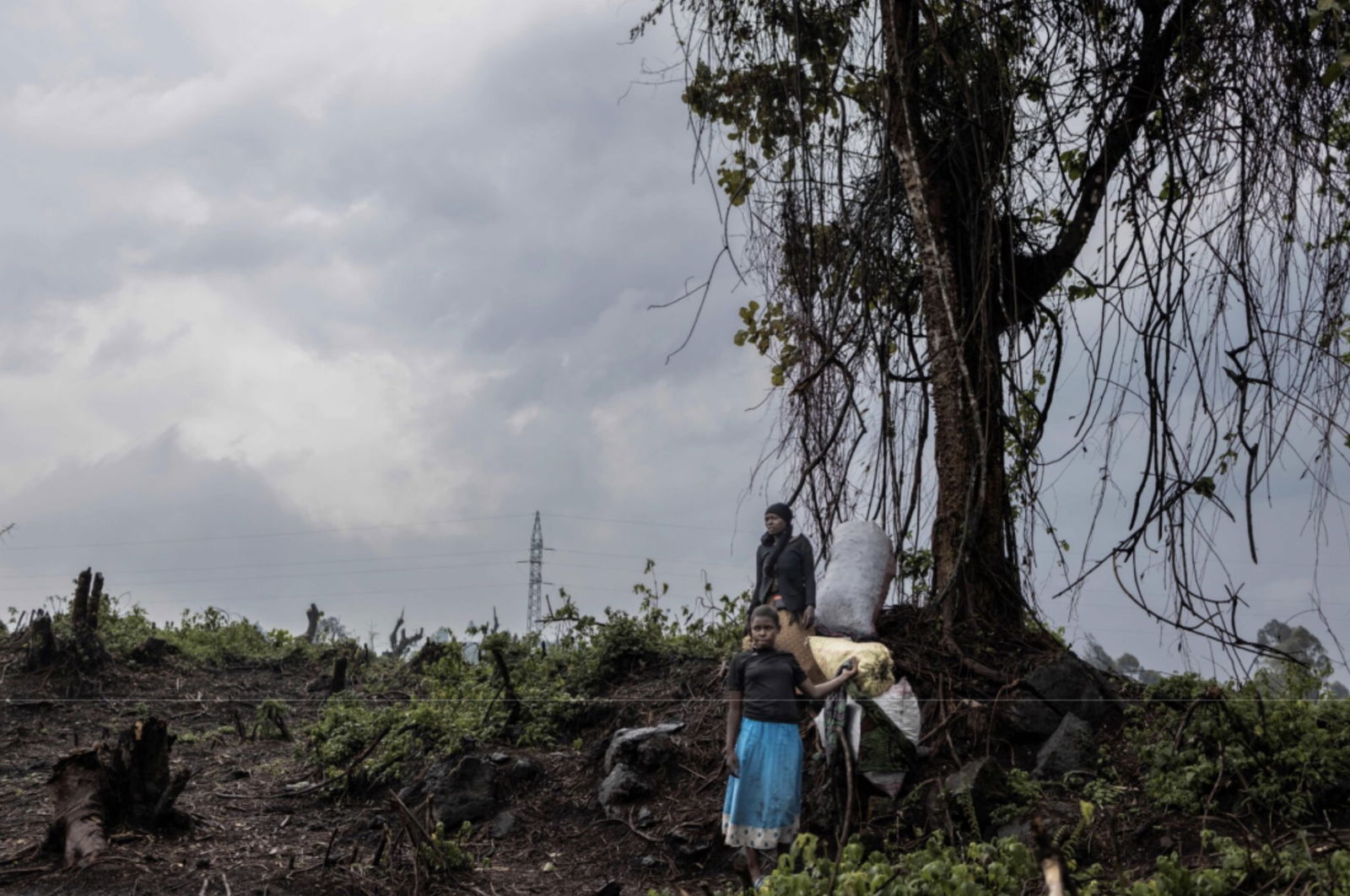
Women carrying charcoal from the forest at the foot of Nyiragongo volcano in Virunga National Park. After the resurgence of the M23 rebellion north of Goma City, tens of thousands of people have crowded into makeshift camps in the Nyiragongo, women and children being the most vulnerable. They are struggling to find enough money, food and energy for their families, so they turned to the commercialisation and use of charcoal (Source: Guerchom Ndebo/AFP via Getty Images)
Biodigesters are emerging as a key technology to address global clean cooking deficits. The HBBS system goes further by integrating smart, low-maintenance AI devices, like smart meters, for real-time energy tracking. This ensures optimal operation and sustainability. Using anaerobic digestion, it converts organic waste into biogas, replacing traditional biomass. Excess bio-slurry serves as organic fertiliser, promoting local farming. The HBBS empowers women by training them as technicians, fostering long-term sustainability and community engagement.
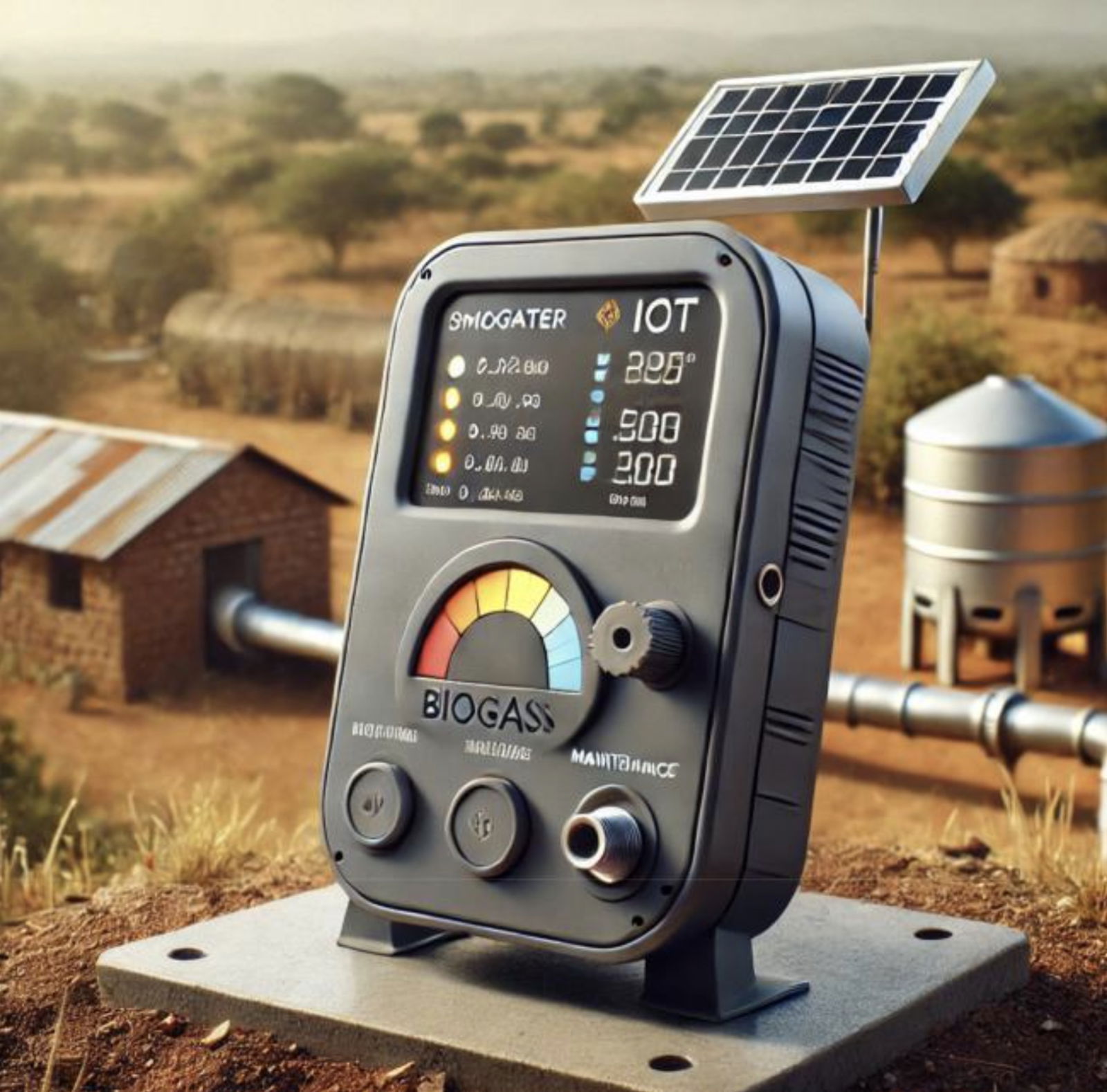
The image above shows a model of the HBBS compact, durable smart meter with an interface for biogas levels and maintenance alerts, designed for outdoor use. The device will be mounted on a biodigester system (Source: Generated with ChatGPT)
Biodigesters harness naturally occurring microbial processes to break down organic matter in oxygen-deprived environments, producing biogas primarily composed of methane (CH₄) and carbon dioxide (CO₂). This gas can be directly used for cooking and heating, offering a clean alternative to wood and charcoal. Unlike centralised energy solutions such as national grids, biodigesters operate at the household or community level, making them particularly suitable for remote, off-grid regions where traditional energy infrastructure is lacking.
In SSA, agricultural and livestock farming dominate rural economies, generating abundant organic waste that often goes unused or poorly managed. The HBBS will convert these wastes into a valuable energy resource, aligning seamlessly with existing rural livelihoods. This dual functionality ‘waste management and energy production’ will address both environmental degradation and energy scarcity.
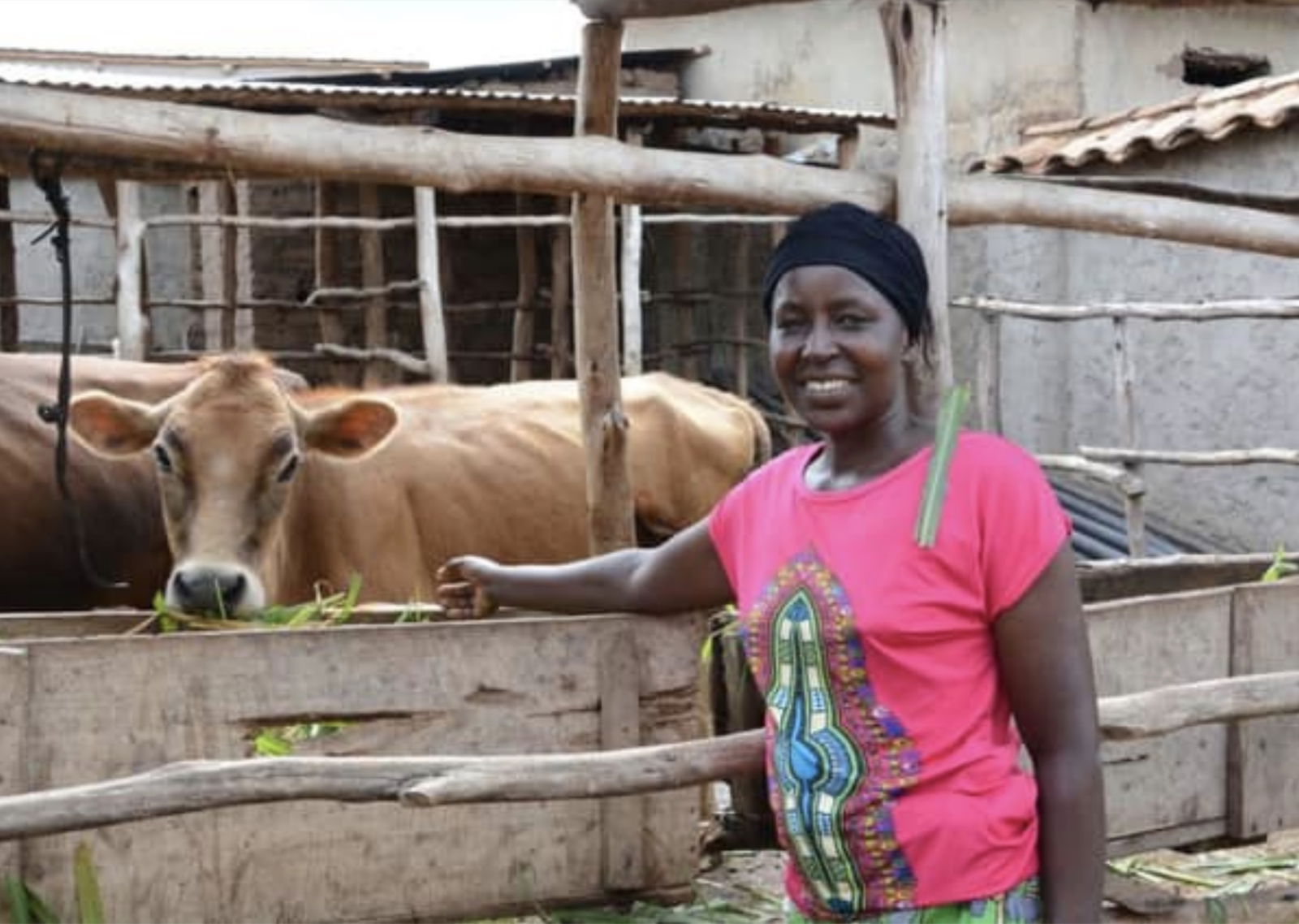
A local woman in cattle rearing in rural Rwanda (Source: NewLife Farming, 2019)
The scalability and adaptability of HBBS will make it an appealing solution. Systems will range from small household units to larger community-scale installations, enabling flexible implementation based on local needs and resources.
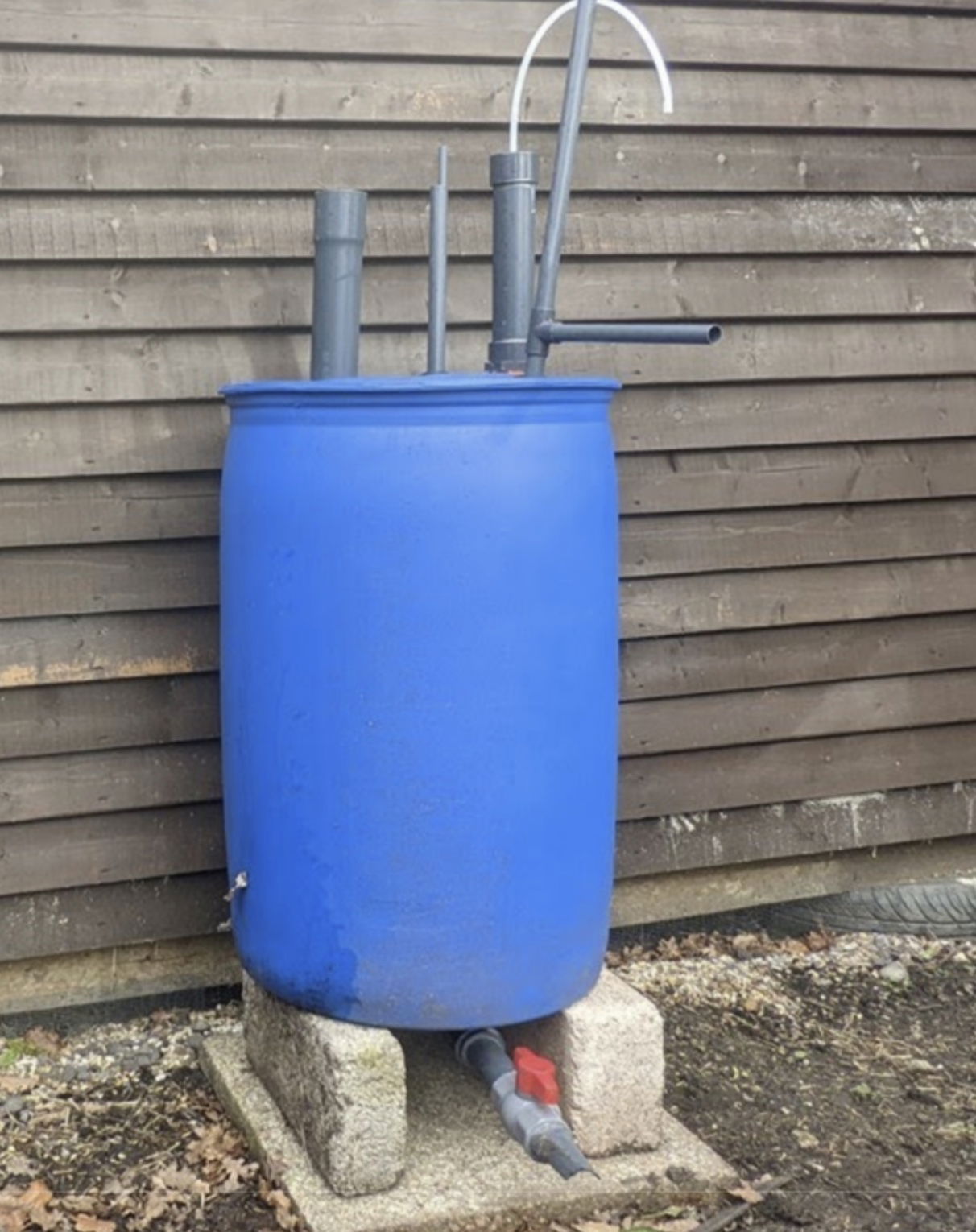
A simple home-based biogas digester made from a repurposed barrel, with pipes for gas collection and waste input/output demonstrating a cost-effective and accessible design for converting organic waste into biogas, suitable for small-scale household use (Source: The EcoCook Project)
To meet the cooking energy needs of an average household of 4–6 members cooking twice daily, the home-based biodigester system would require approximately 25–30 kilograms of organic waste per day. This waste can be sourced from kitchen scraps, animal manure, and agricultural residues, materials commonly found in rural and peri-urban households in SSA. With this input, the biodigester can generate 1 cubic meter of biogas daily
To ensure efficient operation, households will be provided with simple tools such as stoves for burning, weighing scales to measure the daily input of organic waste and gas flow meters to monitor biogas production. This will help families optimise the system and ensure that they generate enough fuel for their needs.The program uses locally sourced organic waste, reducing external dependencies and fostering a circular economy. The biodigester’s bio-slurry byproduct serves as organic fertiliser, boosting agriculture and encouraging HBBS adoption.
The HBBS program will begin with a pilot phase designed to demonstrate its effectiveness and scalability in addressing energy, environmental, and social challenges. This phase will focus on three countries with similar geographical, demographic, and energy access profiles: Kenya, Rwanda, and Tanzania. These countries were chosen for their high reliance on biomass for cooking, significant rural populations, and government support for renewable energy initiatives.
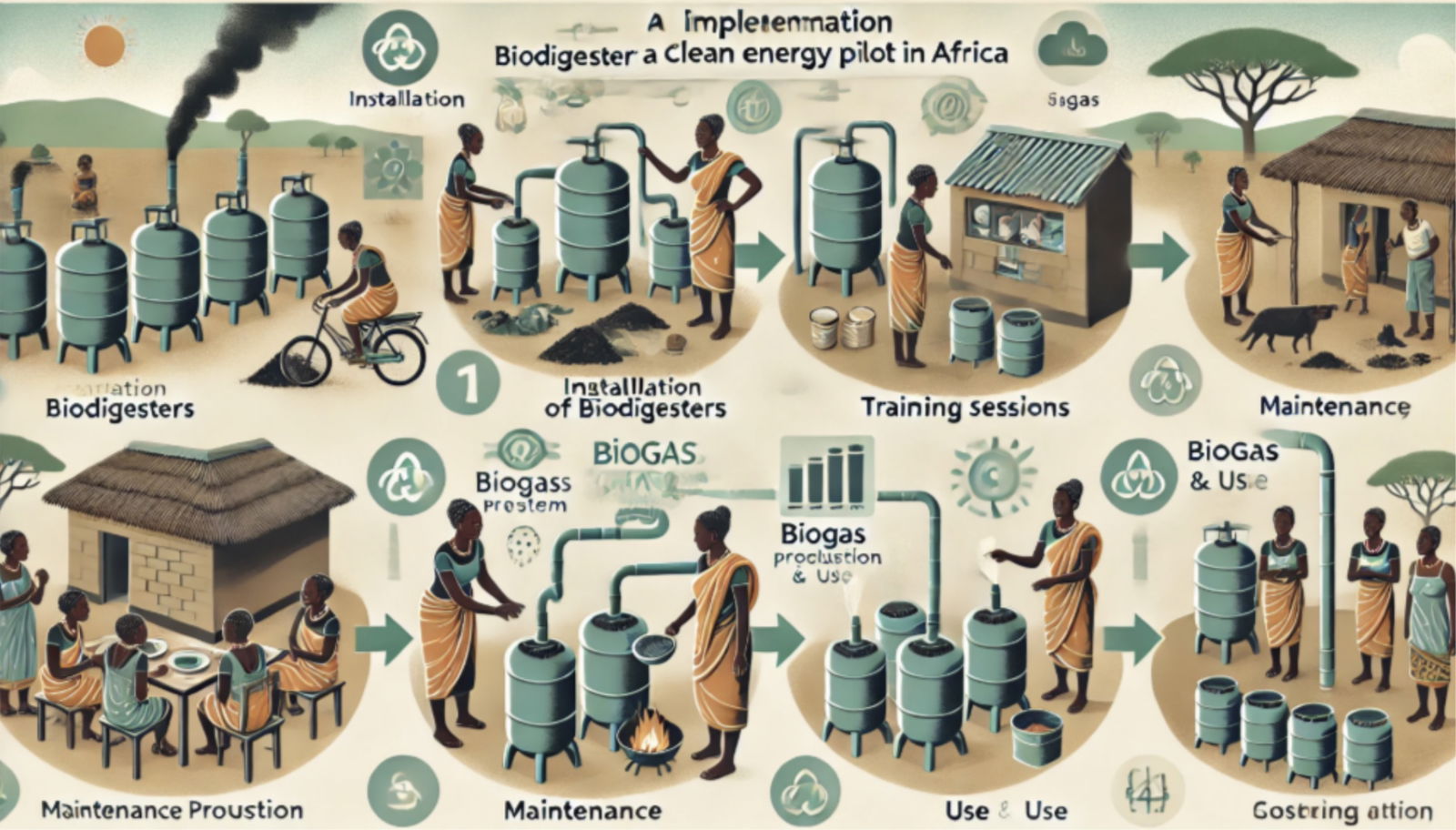
The implementation process showcasing biodigester installation, women’s training, system maintenance, and biogas production for household use.
The pilot phase will engage a sample of 300 households across these three countries, 100 per country, to ensure diversity in cultural and environmental contexts. Households will be selected based on key criteria, including willingness to participate, access to organic waste materials, and existing reliance on traditional cooking methods. This diverse sample will enable the program to gather comprehensive data on the effectiveness of biodigesters under varying conditions, such as differences in climate, waste availability, and cooking practices.
The pilot will run for 18 months, allowing sufficient time for households to adapt to the biodigester systems and provide consistent feedback. During the first six months, the focus will be on installation, training, and community mobilisation. Women will receive hands-on training on operating and maintaining the biodigesters, as well as guidance on utilising the bio-slurry of production as fertiliser and managing potential surplus biogas.
The next six months will focus on integrating the program into daily routines, with monthly feedback from surveys, focus groups, and interviews to assess impact on energy access, time savings, emissions, and economic activities, especially women’s roles in entrepreneurship and leadership.
The final six months will involve a comprehensive evaluation of the pilot, analysing data on biodigester efficiency, community acceptance, and impact. Independent assessments will validate results and guide improvements. Findings will inform scaling strategies and be shared with stakeholders to encourage wider adoption.
To ensure the long term scalability of the Program, a phased expansion strategy post-pilot will be developed to expand across various geographies, socio-economic, and cultural contexts across different regions. The program will identify potential barriers to scaling, such as supply chain logistics, local regulatory environments, and community acceptance, and devise tailored strategies to address these challenges.
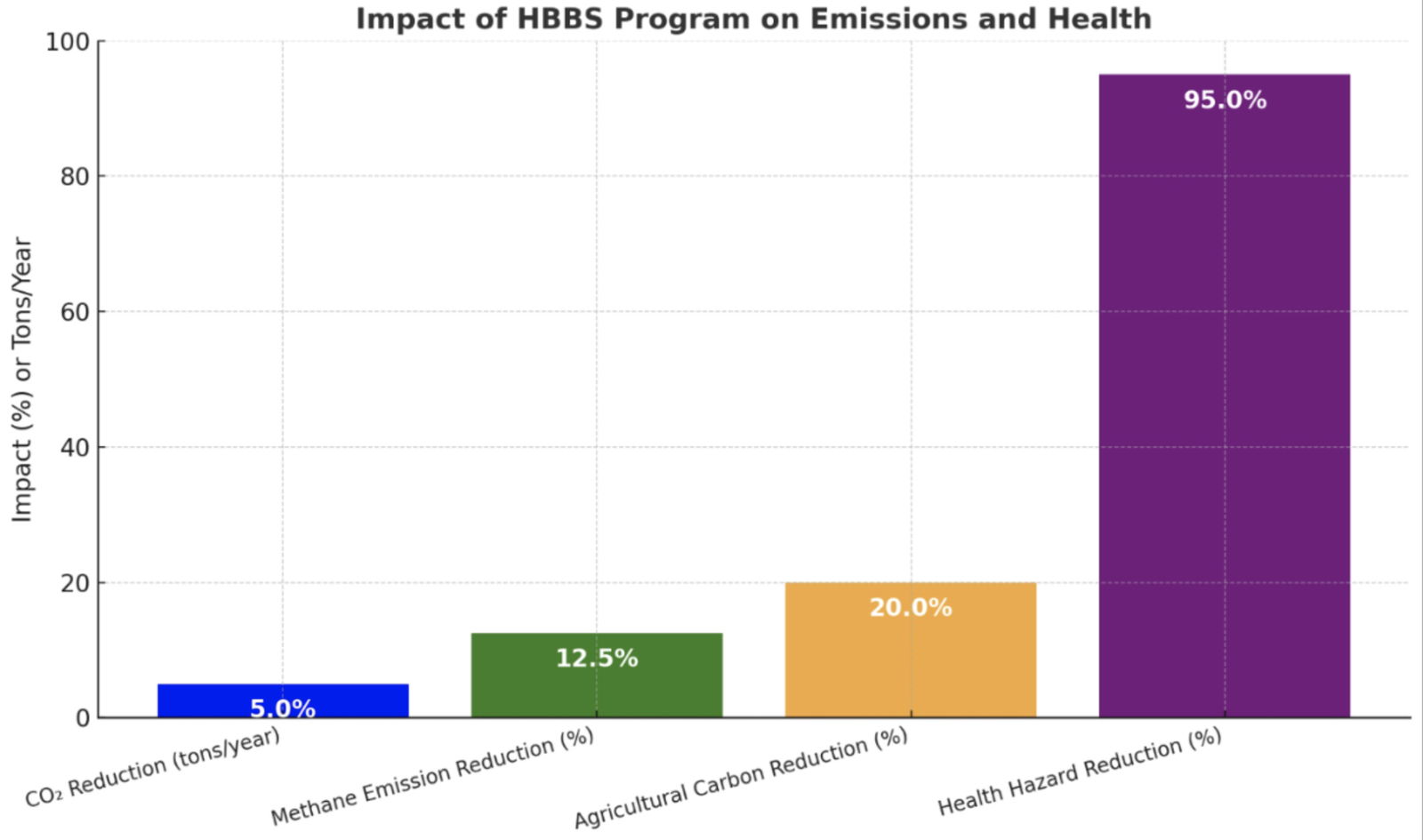
The graph illustrates the HBBS program's potential impact, showcasing reductions in CO₂ emissions, methane emissions, and agricultural carbon footprint, along with a significant 95% reduction in household health hazards from indoor air pollution.
The HBBS program can significantly reduce greenhouse gas emissions. A single biodigester can prevent 4-6 tons of CO₂ emissions annually by replacing firewood or charcoal with biogas, and cut methane emissions by 10-15% from organic waste. Replacing synthetic fertilisers with bio-slurry can reduce agricultural carbon footprints by up to 20%. Health-wise, transitioning to biogas stoves can eliminate up to 95% of indoor air pollutants, preventing nearly 500,000 premature deaths annually in Sub-Saharan Africa due to respiratory and cardiovascular diseases (WHO, 2022).
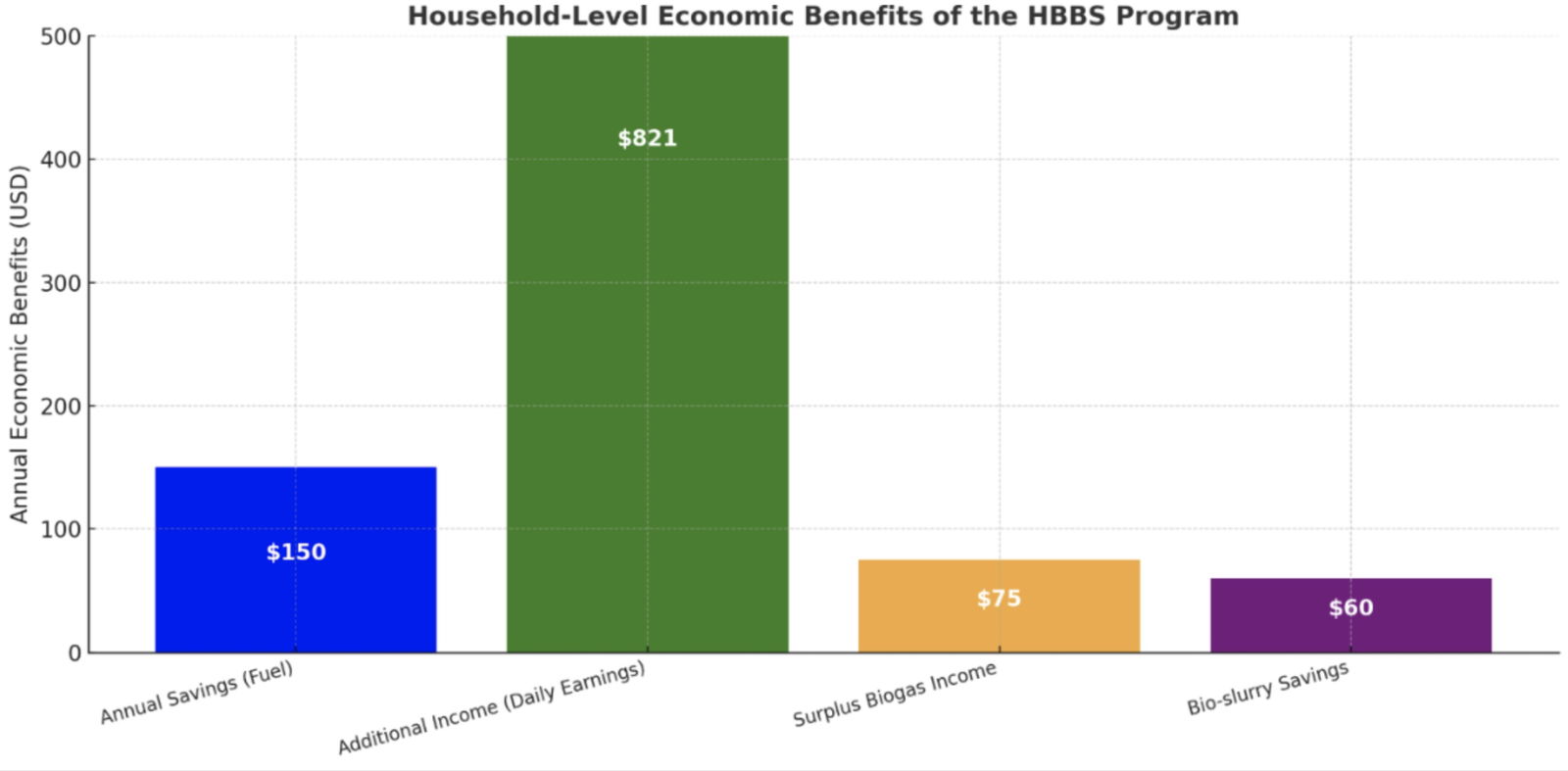
This bar graph visualises the economic benefits of the HBBS program, highlighting household-level savings from fuel costs, additional income opportunities, bio-slurry use, and surplus biogas monetisation.
On average, rural households in Sub-Saharan Africa spend $120–$300 annually on firewood, charcoal, or kerosene, depending on their energy needs and local fuel costs (World Bank, 2021). Hence by switching to biogas through the program, these expenses are eliminated, resulting in direct annual savings of $150 per household on average. Additionally, the time traditionally spent collecting firewood, estimated at 2–4 hours per day for many rural women (UNDP, 2022), can be redirected towards income-generating activities.
Surplus biogas from biodigesters can be sold for $50–$100 annually per household, while bio-slurry can save $60 on fertilisers or generate income if sold. At the community level, women-led micro-enterprises in biogas and bio-slurry could generate $5,000–$10,000 annually, boosting local economic resilience. These savings and earnings enhance women’s financial independence and promote grassroots economic growth.
The HBBS program identifies a critical gap in existing bioenergy initiatives like Maji ni Uhai and Econexus, which have focused primarily on expanding access to clean energy without ensuring long-term functionality and sustained impact. Unlike these programs, HBBS bridges this gap by prioritising ongoing functionality and durability over mere access, incorporating robust follow-ups and regular maintenance checks to ensure systems remain operational and effective months after installation. This approach addresses the shortcomings of existing initiatives, ensuring that clean energy solutions deliver consistent and lasting benefits to communities.
Unlike previous programs focused on urban areas or external supply chains, HBBS targets rural and peri-urban communities where over 70% rely on biomass fuels. The program works with households producing 20–30 kg of organic waste daily to generate 1 cubic meter of biogas, meeting the needs of a family of five. Using diverse waste streams ensures a reliable feedstock, avoiding seasonal shortages. Flexible financing models, like pay-as-you-go and micro-loans, reduce upfront costs to as low as $100, making biodigesters more affordable for low-income households.

This image illustrates a pay-as-you-go system for clean energy, showing a user interacting with a mobile money-enabled device for energy (Source: TechAfrica News, 2024)
Unlike earlier programs, HBBS positions women as the primary producers and managers of decentralised biogas systems, empowering them to generate economic and social value. Participating women will receive comprehensive training in biodigester, waste management, and business development, with the potential to save $150–$300 annually on fuel costs and generate additional income of $50–$100 annually by selling surplus biogas or bio-slurry. Each digester offsets approximately 15 tons of CO₂ emissions annually, reducing deforestation, improving air quality, and enhancing community health. The program also addresses the rural employment gap by training women as technicians, creating up to 5,000 new jobs per 100,000 households engaged in the program. This decentralised, community-driven approach will reduce reliance on external actors and also strengthen community cohesion by enabling women to act as local energy leaders. In addressing gaps in scalability, affordability, and cultural integration seen in other programs, HBBS will offer a transformative model that delivers substantial environmental, economic, and social benefits, ensuring its long-term sustainability and replicability across sub-Saharan Africa.
The HBBS program addresses the affordability barrier to clean energy adoption through innovative and accessible financing mechanisms designed to ensure inclusivity and long-term sustainability. To kick start the program, partnerships with microfinance institutions (including Commission Bancaire de l'Afrique Centrale & CEMAC, Rural banks), development banks (including Agricultural Development Bank & Africa Development Bank) and NGOs (Clean Cooking Alliance & SEforALL) will enable households to access low-interest loans, grants, and subsidies to cover the initial costs of biodigester installation
Public sector support, including subsidies and tax incentives, will align with SDG and climate goals. Private sector partnerships will ensure efficient biodigester production and distribution, fostering a circular economy. Philanthropic funding from the World Bank, UNDP, and climate funds will provide seed funding and expertise during the pilot phase.
Revenue generation from bio-slurry fertiliser sales and biogas distribution will create ongoing income for participants, enhancing program sustainability. With robust monitoring and evaluation mechanisms in place, the program will refine its operations and expand through a phased approach, creating regional hubs to coordinate scaling efforts. Conclusion
The Home-Based Biogas Program (HBBS) is a transformative initiative addressing energy poverty, gender inequality, and environmental degradation in Sub-Saharan Africa. By empowering women as leaders in local energy solutions, HBBS envisions self-reliant households driving sustainable growth. Beyond clean cooking, it empowers communities to improve health, reclaim resources, and contribute to global climate action.
The success of HBBS relies on collective action. Governments must integrate it into development and climate strategies, the private sector must invest, and financial institutions must provide accessible financing. Development organisations and philanthropies must offer expertise and funding. This is a call to unite stakeholders for equitable progress, proving that sustainability and inclusivity go hand in hand.
The window to act is narrowing. Energy poverty, climate change, and gender inequity are converging crises that demand immediate, ambitious solutions. HBBS is that solution, a proven, adaptable model poised to rewrite the story of energy access in sub-Saharan Africa. When all actors join this effort, stakeholders can help build a future where clean energy is more than a privilege but also a right, where women lead with agency, and where communities thrive in harmony with the environment. The time to champion this transformative change is now. Let’s act decisively to turn this vision into a lasting legacy.
illuminem Voices is a democratic space presenting the thoughts and opinions of leading Sustainability & Energy writers, their opinions do not necessarily represent those of illuminem.
Yury Erofeev

Food · Agriculture
illuminem briefings

Sustainable Lifestyle · Food
illuminem briefings

Sustainable Lifestyle · Food
Axios

Food · Sustainable Lifestyle
The Independent

Climate Change · Food
Forbes

Sustainable Lifestyle · Food